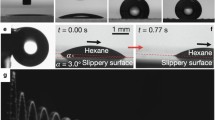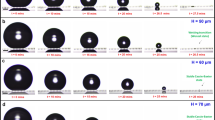Abstract
In this paper, a grooved mushroom structured surface, with superoleophobicity and anisotropic flow of hexadecane with a low surface tension is reported. The grooved mushroom structure was fabricated using a simple and cost-effective wet etching process on Si wafer. The wetting properties of the fabricated surface were studied through static contact angle (CA), contact angle hysteresis (CAH), and tilted angle measurements in the parallel and orthogonal directions. The maximum static CA of hexadecane droplets was 159° in the parallel direction and 142° in the orthogonal direction, respectively. The results from the CAH measurements indicated that the wetting and flow on the grooved mushroom structure were anisotropic. Furthermore, it was verified experimentally that the ridge height and distance between the top layers were key to determining the oleophobicity and anisotropic flow.







Similar content being viewed by others
References
Ahuja A, Taylor JA, Lifton V, Sidorenko AA, Salamon TR, Lobaton EJ, Kolodner P, Krupenkin TN (2008) Nanonails: a simple geometrical approach to electrically tunable superlyophobic surfaces. Langmuir 24:9–14
Bixler GD, Bhushan B (2014) Rice- and butterfly-wing effect inspired selfcleaning and low drag micro/nanopatterned surfaces in water, oil, and air flow. Nanoscale 6:76–96
Cassie ABD, Baxter S (1944) Wettability of porous surfaces. Trans Faraday Soc 40:546–551
Chen Y, He B, Lee J, Patankar NA (2005) Anisotropy in the wetting of rough surfaces. J Colloid Interface Sci 281:458–464
Choi W, Tuteja A, Mabry JM, Cohen RE, Mckinley GH (2009) A modified Cassie–Baxter relationship to explain contact angle hysteresis and anisotropy on non-wetting textured surfaces. J Colloid Interface Sci 339:208–216
David R, Neumann AW (2012) Shapes of drops in the Cassie state on grooved surfaces. Colloids and Surfaces A: Physicochem. Eng Aspects 399:41–45
Dufour R, Harnois M, Coffinier Y, Thomy V, Boukherroub R, Senez V (2010) Engineering sticky superomniphobic surfaces on transparent and flexible PDMS substrate. Langmuir 26:17242–17247
Hancock MJ, Sekeroglu K, Demirel MC (2012) Bioinspired directional surfaces for adhesion, wetting, and transport. Adv Funct Mater 22:2223–2234
Kim B, Shin S, Shin S, Kim K, Cho H (2011) Micro-nano hybrid structures with manipulated wettability using a two-step Si etching on a large area. Nanoscale Res Lett 6(333):1–10
Lee D, Lee J, Cho Y (2013) Effects of grooved surface with nano-ridges on amplification of hydrophobic property. Adv Mater Res 684:26–31
Lee D, Lee E, Cho Y (2014) Fabrication of superoleophobic surface with anisotropic wettability using Si wafer. J KSMTE 23:533–538
Tuteja A, Choi W, Ma M, Mabry JM, Mazzella SA, Rutledge GC, Mckinley GH, Cohen RE (2007) Designing superoleophobic surfaces. Science 318:1618–1622
Tuteja A, Choi W, Mckinley GH, Cohen RE, Rubner MF (2008) Design parameters for superhydrophobicity and superoleophobicity. MRS Bull 33:752–758
Wenzel RN (1936) Resistance of solid surfaces to wetting by water. Ind Eng Chem 28:988–994
Wu T, Suzuki Y (2011a) Design, microfabrication and evaluation of robust high-performance superlyophobic surfaces. Sens Actuators B 156:401–409
Wu T, Suzuki Y (2011b) Engineering superlyophobic surfaces as the microfluidic platform for droplet manipulation. Lab Chip 11:3121–3129
Zhao H, Law K (2012) Directional self-cleaning superoleophobic surface. Langmuir 28:11812–11818
Acknowledgments
This work was supported by the National Research Foundation of Korea (NRF) Grant (2014K2A2A7060928 and 2012R1A1A1007868).
Author information
Authors and Affiliations
Corresponding author
Rights and permissions
About this article
Cite this article
Lee, DK., Lee, EH. & Cho, Y.H. A superoleophobic surface with anisotropic flow of hexadecane droplets. Microsyst Technol 23, 421–427 (2017). https://doi.org/10.1007/s00542-016-2945-9
Received:
Accepted:
Published:
Issue Date:
DOI: https://doi.org/10.1007/s00542-016-2945-9




